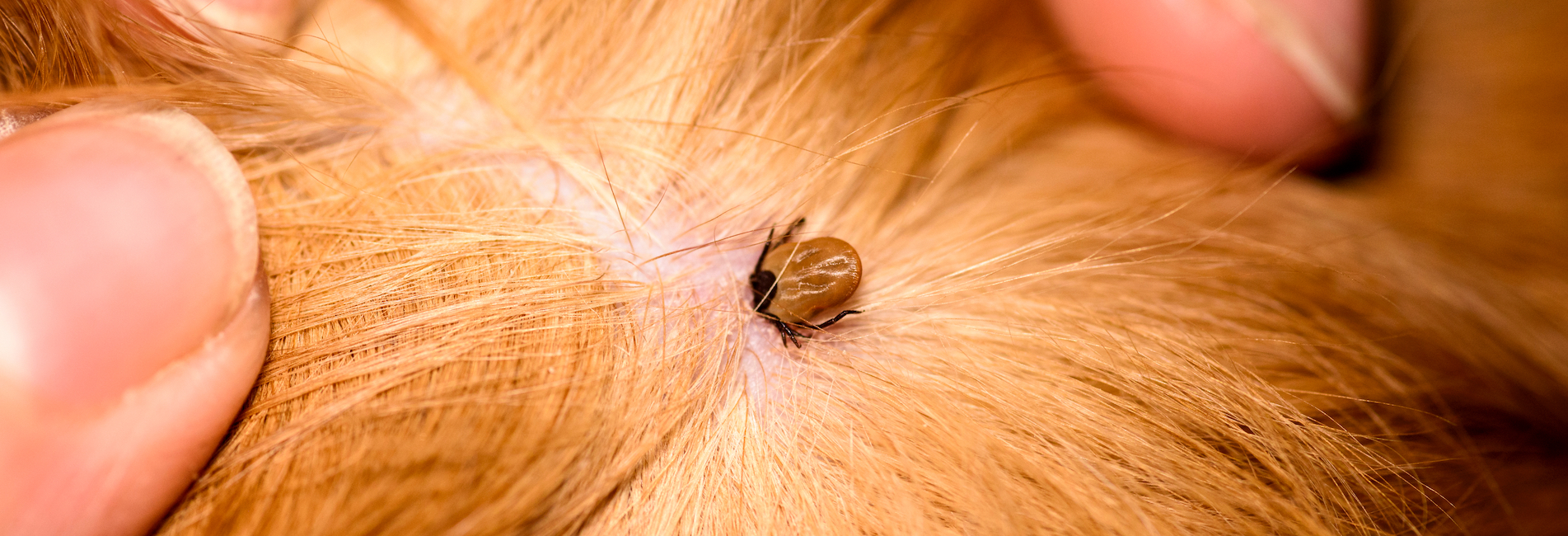Ticks are common in the UK. A tick is an arachnid as opposed to an insect. They have 8 legs and vary in size from 1 millimetre to 1 centimetre. Ticks hatch from eggs and develop into larvae, then nymphs, and finally into adults. Through each stage, ticks need to attach themselves to and feed from an animal (which becomes their host), to develop into the next stage. When younger, ticks will prefer to feed on small animals such as birds and rodents. The later stages of a tick will attach onto and feed on larger mammals, such as dogs and cats, as well as humans.
Where can my pet get ticks from
Ticks are most likely to be found amongst vegitation, in areas like woodland, meadows and moors. When they need to attach themselves to a new host, they will wait on low branches and leaves to attach to any animal who brushes past them.
When is my pet likely to be affected
Ticks tend to be at their most active during the spring and early summer, then again in the early autumn. Ticks are generally dormant during the cold weather. However, as the global temperature rises, it is likely they will be active for a greater amount of the year.
What can a tick bite cause
On the whole, a tick bite will not cause harm to your pet. On rare occasions, bacterial infections or abscesses will develop at the site of a bite. The chances of this happening increase if a tick has been removed incorrectly, with the mouth of the tick remaining in your pets skin. The main reason you will want to stop a tick from biting your pet is that they have the potential to act as spreaders of infectious disease.
What diseases can be spread by ticks?
In the UK, the most common disease that ticks can transmit is Lyme disease, caused by the bacterium Borrelia burgdorferi. It is important to note that not all dogs that are bitten by a tick become ill. Many dogs in the UK have antibodies in their blood to the bacterium, which suggests they have been exposed but may never have shown the signs of being unwell. Despite this, some dogs will become ill. Symptoms can occur anything from weeks to months after the initial bite. Symptoms of lyme disease in dogs can include swollen and painful joints, tiredness, and a fever. Lyme disease can also affect humans, with rashes in the area of the bite showing as a side-effect of being bitten by a disease carrying tick. The rash tends not to be seen in dogs. In humans, lyme disease can become a long-term illness, with heart rhythm abnormalities, neurological problems and arthritis all being effects.
Preventing your pet from getting ticks
Frequently check your dog for ticks and remove any that you find. If you have been walking in areas that are high risk, either in location or the time of year, check your dog following the walk, and then daily for the next week or so. Be sure to check them thoroughly, running your hand against the direction of the hair growth, and if you feel anything, check beneath the hair to see if it is a tick. Ticks can be attached anywhere on your dog, but be sure to check the feet, groin and armpits. Cats can also get ticks, however tend to be quite effective at cleaning them off themselves. Nevertheless, check them over, paying particular attention to their head, which they cannot clean as easily. There are a number of preventative tick treatments available which will repel ticks or kill them once they have attached. Infected ticks do not spread infections such as Lyme disease until they have been biting the host for about 48 hours. The most effective tick treatments will kill ticks far quicker than this.
How to remove a tick from your pet
The most effective way of removing a tick is by twisting it off using a special tick remover. We have found the Tick Twister to be the best tool for doing this. If you can properly remove a tick in this way, it will reduce the risk of leaving the mouth of the tick attached. Failure to do this could lead to an infection developing in your pet. You must never remove a tick by squeezing or pulling it off. If you squeeze it, you risk releasing disease directly into your pet, and pulling it off it likely to leave the mouthpiece. Once you have twisted the tick off, place it on some tissue and check it's mouth is still attached. If done correctly, the tick will normally still be alive and begin to crawl. The best advice, if possible, is to keep the tick secure somewhere, in case you do need to visit a vet. Ticks are difficult to kill through squishing them so be careful where you dispose of them if you choose to do so. In all cases, if you struggle to remove a tick, seek the advice of a vet.




